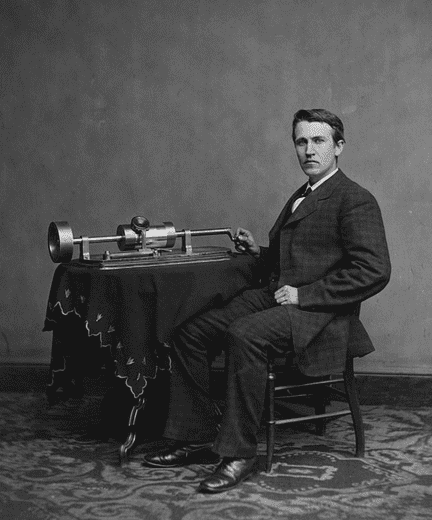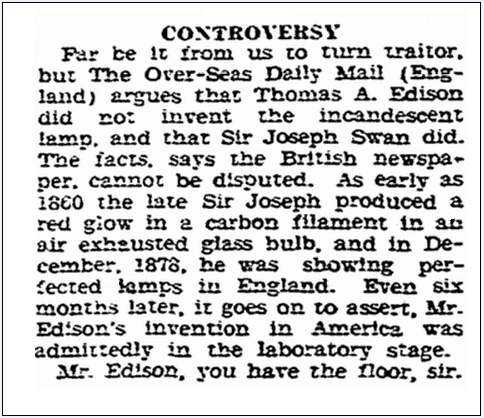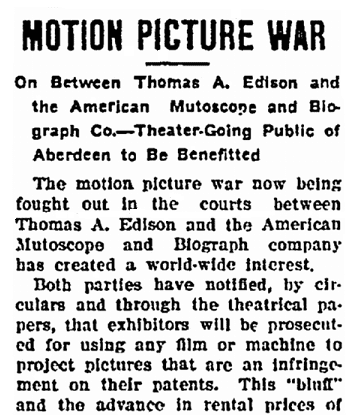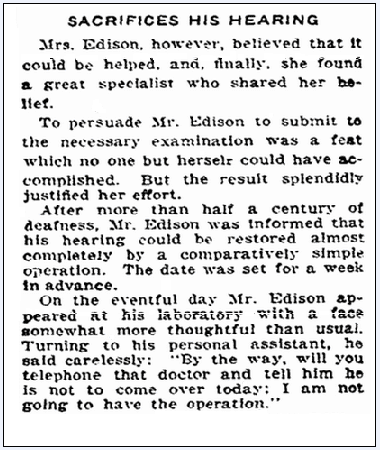Podcast: Play in new window | Download
Introduction: In this article, Mary Harrell-Sesniak searches old newspapers to learn more about the amazing life and accomplishments of the great inventor Thomas Edison. Mary is a genealogist, author and editor with a strong technology background.
As you observe your family members enjoying conveniences such as talking on cellphones, downloading music, charging batteries and living in a well-lit house, remind them to give thanks to Thomas Edison. These modern devices wouldn’t exist without him.

Edison’s Early Years
Born on 11 February 1847 in Milan, Ohio, Thomas Alva Edison was the youngest of seven children born to Samuel and Nancy (Elliott) Edison. His mother died in 1871 and his father died in 1896 at the age of 91. According to Samuel Edison’s obituary below, the family’s ancestors arrived in North America long before the American Revolution. There’s a good chance many of our readers, including myself through his Beach and Merriman lines, are distant cousins of Thomas Edison. (See famouskin.com and Thomasedison.org.)

Home Schooling – and Deafness
Thomas Edison had little formal schooling. After his teachers reported him to be a slow learner, his mother decided that home schooling was a better method to educate her son.
For someone who made so many inventions involving sound, it is startling to learn that Edison was almost completely deaf. At the age of 12, he either contracted scarlet fever or had an accident which left him severely hearing-impaired. The National Park Service’s Thomas Edison page reports that Edison once wrote: “I have not heard a bird sing since I was twelve years old.” Another story, which Edison himself told, was that he “was picked up by the ears to keep from falling out of a train” and this caused something to pop inside his ears.
The genius behind so many amazing inventions never attended college or technical school. He learned through his mother’s home schooling, his own voracious reading, and constant experimentation. His inventions amazed our ancestors and they continue to impact us today. No wonder he was called the “Wizard of Menlo Park,” the location in New Jersey where he built a laboratory in 1876.
Inventions and Patents
Despite his genius and remarkable inventions, however, most children today are not taught much about Thomas Edison other than a few lines in a history book. Nor can many young people identify his inventions, even though Edison achieved 1,093 or more patents (some report 1,368) in his lifetime.
According to the History Channel’s Thomas Edison page, many of his patents addressed telephony, telecommunications and electricity – so imagine where we’d be without them.
Here are some of his many achievements:
- 195 patents for telephony, the phonograph, and their improvements, starting in 1876
- 34 patents for the telephone, beginning in 1878
- 389 patents for electric light and power, including the first commercially-successful incandescent light bulb in 1879
This is his patent for the telephone of 1883.

Invention of the Phonograph
In 1877, Edison invented the phonograph – a device to record people’s voices that greatly amazed the public. At that time, people could hardly imagine a machine that can record your voice now, so that your ancestors hundreds of years later can hear what your voice sounded like! It seemed as though Edison was truly a wizard. As this newspaper article reports:
Speech has become, as it were, immortal.

For his own first recording, Edison recited the beloved children’s poem “Mary Had a Little Lamb.” It is wonderful and almost magical, even in our own age of technological marvels, to hear Edison’s own voice from so very long ago. You can hear him reciting the poem here.
Controversies
Edison arrived at some of his invention ideas simultaneously with others, and in some cases his inventions were based on the breakthroughs of his predecessors. Consequently, you’ll find various reports objecting to giving Edison credit for some of his inventions – controversies that erupted during Edison’s lifetime and in some cases continue today.
For example, the invention of the light bulb is often credited to Edison, although Sir Joseph Swan (1828-1914) and at least 22 other inventors came up with the idea before him. Where they failed to perfect their ideas, however, Edison succeeded, as he always strove to use superior materials and clever marketing to materialize and promote his inventions. His incandescent light bulb can truly be said to be the father of modern lights.

Another controversy involving Edison resulted from patents pertaining to the movie industry. As seen in this article, Edison strongly protected his inventions in the courts in 1908. In the end, he won.

More Breakthrough Edison Inventions
I could literally write a book about Thomas Alva Edison’s inventions. Many of his inventions that should be common knowledge include these:
- An early stock ticker machine, around 1869
- The “Improvement in Phonograph or Speaking Machine,” in 1878
- A motion picture camera called the Kinetograph, in 1891
- The Kinetophone, or talking motion picture, in 1912
- The first steel alkaline storage batteries, 1900-1910
- The battery which was introduced on the Model T for Henry Ford, in 1908
- The telescribe, which allowed for recording both sides of a telephone conversation, in 1914
- Various military devices during World War I, including detection devices for airplanes, submarines, periscopes and guns by sound ranging, as well as ship camouflaging
However, there is one product he didn’t create – and why he didn’t do so is one of the greatest mysteries of all time.
Mysterious Invention Oversight
With his nearly complete hearing loss, why didn’t Edison invent a hearing aid?
The stories of how he coped with his damaged hearing are heart-wrenching. In order to improve the clarity of sound, his method was to place his ear against a phonograph cabinet and bite on wood. Surprisingly, this seemed to improve his hearing. While raising our family in Fort Myers, Florida, we’d often visit Edison’s Winter Estate – and we all remember viewing furniture with his bite marks.
Apparently, Edison’s poor hearing bothered the people around him more than himself. Some theorize he preferred silence over distracting noises. In 1914, his wife Mina located a physician who had hopes of fully restoring Edison’s hearing. He agreed to undergo the procedure, but on the day of the operation Edison told his personal assistant:
By the way, will you telephone that doctor and tell him he is not to come over today: I am not going to have the operation.

Perhaps Thomas Edison truly preferred to concentrate in a world of near-silence.
Additional Thomas Edison Resources:
- Links to Thomas Edison inventions at Google Patents
- The 1903 film The Great Train Robbery, patented by Edison and made by Edwin S. Porter and others. (See http://www.loc.gov/item/00694220 – Library of Congress).
- Download and print the “Young Inventors History Detective Challenge” courtesy of Edison’s Winter Estate in Fort Myers, Florida.
Related Thomas Edison Articles:

